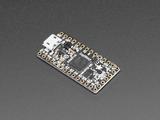Adafruit ItsyBitsy M4 Express featuring ATSAMD51

Description
What's smaller than a Feather but more powerful than a Trinket? It's the Adafruit ItsyBitsy M4 Express. Compact yet potent, this microcontroller board boasts a lightning-fast ATSAMD51 Cortex M4 processor running at 120 MHz.
Specifications:
- ATSAMD51 32-bit Cortex M4 core at 120 MHz
- 512 KB Flash and 192 KB RAM
- 23 digital GPIO pins with multiple functionalities
- Dual 1 MSPS 12-bit DAC for stereo audio
- 2 MB SPI Flash for data storage
- Built-in CircuitPython, no IDE needed
- Native USB support compatible with Arduino and CircuitPython
Enjoy seamless integration with your projects using CircuitPython or Arduino IDE. Its tiny form factor makes it ideal for transitioning from prototyping on a Metro M4 to creating compact final projects.
Utilize its wide array of pins for extensive connectivity, from NeoPixels to servos. With built-in AES crypto engines and DMA-NeoPixel support, the ItsyBitsy M4 adapts swiftly to your creative demands with speed and security.
Properties
Brand information
| Brand | Adafruit |
| Model | 3800 |
€ 18,75€ 15,50 Excl. VAT (NL)
ETA is not known
Alternatives in stock
Micro USB Cable
Show more results
Alternative products
- SparkFun Thing Plus - SAMD51 € 31,75 View product
- Adafruit ItsyBitsy M0 Express - for CircuitPython & Arduino IDE € 15,- View product
- Adafruit Feather M4 Express - Featuring ATSAMD51 € 28,50 View product
- SparkFun SAMD21 Mini Breakout € 31,- View product
- In stock Adafruit ItsyBitsy nRF52840 Express - Bluetooth® LE € 25,- View product
- Adafruit ATSAMD09 Breakout with seesaw € 6,25 View product
- DFRobot Firebeetle 2 Board-M0 (V1.0) € 11,25 View product
Related products
- In stock Opencircuit Micro USB cable 50 cm blue € 1,50 View product
- In stock Opencircuit Micro USB cable 100cm blue - 30AWG € 3,20 View product
- Adafruit USB micro B Cable with LEDs - Blue and Green € 8,75 View product
- Adafruit USB micro B Cable with LEDs - Blue and Red € 8,85 View product
- DFRobot Reversible USB to microUSB 2.0 Cable with Antioxidant Connectors € 4,- View product
Customer questions
Q
Customer Reviews
Adafruit ItsyBitsy M4 Express featuring ATSAMD51 ★★★★★Click a star to leave your review
- In stock Adafruit White LED Backlight Module - Medium 23mm x 75mm € 3,25 View product
- In stock Adafruit NOOds - Flexible LED Filament - 3V 300mm long - Red € 9,50 View product
- 3 pieces In stock Adafruit LED Filament - 3V 26mm long - Warm White 3 Pack € 5,75 View product
- In stock Adafruit I2S 3W Class D Amplifier Breakout - MAX98357A € 7,50 View product
- In stock Adafruit NOOds - Flexible LED Filament - 3V 300mm long - Blue € 9,50 View product
- In stock Adafruit IR Break Beam Sensors with Premium Wire Header Ends - 3mm LEDs € 3,75 View product
- In stock Adafruit Mono 2.5W Class D Audio Amplifier - PAM8302 € 5,- View product
- In stock Adafruit Woven Conductive Fabric - 20cm square € 6,25 View product
- In stock Adafruit IR Break Beam Sensor with Premium Wire Header Ends - 5mm LEDs € 7,50 View product
- In stock Adafruit Mini Metal Speaker w/ Wires - 8 ohm 0.5W € 2,50 View product
- In stock Adafruit Electret Microphone Amplifier - MAX4466 with Adjustable Gain € 8,75 View product
- In stock Adafruit Breadboard-friendly 2.1mm DC barrel jack € 1,25 View product
- 5 pieces In stock Adafruit NeoPixel Diffused 5mm Through-Hole LED - 5 Pack € 6,25 View product
- In stock Adafruit Stereo Enclosed Speaker Set - 3W 4 Ohm € 9,50 View product
- In stock Adafruit NOOds - Flexible LED Filament - 3V 300mm long - Lime Green € 8,75 View product










